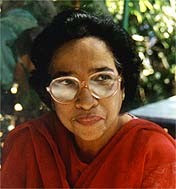Anna Mary Robertson a folk artist of the 20th Century
proved that Age is no bar to living a fruitful life. As Longfellow said “Nothing
is too late until the tired heart ceases to palpitate.”
Anna was born on 7th September, 1860, at
Greenwich, New York. Her father was a small-time farmer, and she was third
daughter in a family of ten. Her father recognized her passion for Art and
would buy for her white paper sheets for her drawings. She would use lemon and
grape fruit juice, grass, flour paste or saw dust to colour her drawings. Anna
attended school for just a short time.
At the age of 12, she became house keeper of a family and
worked there for fifteen years. Her employers too recognized her interest in
Art and provided her with chalk, wax and crayons. Apart from cooking and
cleaning, Anna also did sewing and embroidery. She embroidered colourful
landscapes on cloth and attractive quilted objects for family and friends, from
1930 till her 76th year when she began to develop arthritis. Using
needle and thread for her embroidery became painful. Her sister suggested that
painting would be easier.
So in 1918 at the age of 78, Anna started painting every
day until she was 90. When her right hand grew tired, she would paint with her
left hand, but never gave up. She generated more than 1500 canvases and
initially sold them for a pittance.
In 1938, an Art collector Louis J Calder discovered her
paintings in the window of a drug store in Hoosick Falls, New York. He bought
all of them and promoted her work among New York Art dealers. In 1939, three of
her paintings were exhibited in the New York Museum of Modern Art, titled “Contemporary
Unknown Painters.”
This was followed by
solo exhibitions in New York, other parts of USA and later in Europe for the
next twenty years. Bennington Museum in Vermont has the largest collection of
her paintings.
In 1887, Anna was married at the age of 27, to Thomas
Solomon Moses a farmer. They stayed in Virginia for two decades and had ten
children. But only five survived. Always an industrious woman, Anna not only
worked on the farm but supplemented their income by making and selling potato
chips and butter churned from cows’ milk. In 1905, the couple relocated to
Eagle Bridge, New York. Thomas died in 1927. Anna continued to run the farm
with the help of her son Forrest.
Anna portrayed pastoral scenes in different seasons, like
snow fall in winter or budding greenery in spring. She also painted people
engaged in farm activities. She was completely self- taught and developed her
own style of painting from top to down- first the sky, then the hills down to
houses, people and cattle. The luminous colours she used imbued her paintings
with life. Artists may have thought her art was primitive and called it “Naïve Art,”
but it never bothered her. “I paint to keep busy and pass the time away,” she
said. She drew from memory.
A German critic
remarked, “The unrest and neurotic insecurity of present day make us inclined
to enjoy the simple, and affirmative outlook of Grandma Moses. She depicted the
world as beautiful and good.”
Judith Stein an Art
historian said she was ‘a cultural icon. The spry, productive nonagenarian was
continually cited as an inspiration to house wives, widows and retirees.’
Jean McMahon, Professor
of Women’s Studies called her a ‘homespun feminist who advocated Women’s Suffrage.’
Grandma Moses escaped
from the feeling of domestic confinement through Art and her paintings.
In 1950, the National Press Club cited her as one of the
five most newsworthy women.
At 88 years, Mademoiselle
Magazine called her ‘The Youngest Woman of the Year.’
After retirement from farm work Anna moved in with her
daughter. In 1952, she published her autobiography “My Life History.” She wrote
“I look on my life as a good day’s work………Life is what we make it. Always has
been, always will be.”
The ‘tiny, lively woman with mischievous grey eyes and
quick wit’ won numerous awards and two honorary doctorate degrees.
Her 100th
birthday was celebrated as “Grandma Moses Day” by Nelson Rockefeller. In the September
19th, 1960 issue of Life Magazine, Grandma Moses was featured on the
cover page.
She died at the age of
101, on December 1st, 1961, at a healthcare centre in Hoosick Falls,
New York, and was buried in Maple Grove Cemetery.
President John Kennedy said,
“Death of Grandma Moses removed a beloved figure from American life. The
directness and vividness of her paintings restored a primitive freshness to our
perception of American life.”
Grandma Moses leaves behind the message that Age is no
bar to a productive life.

